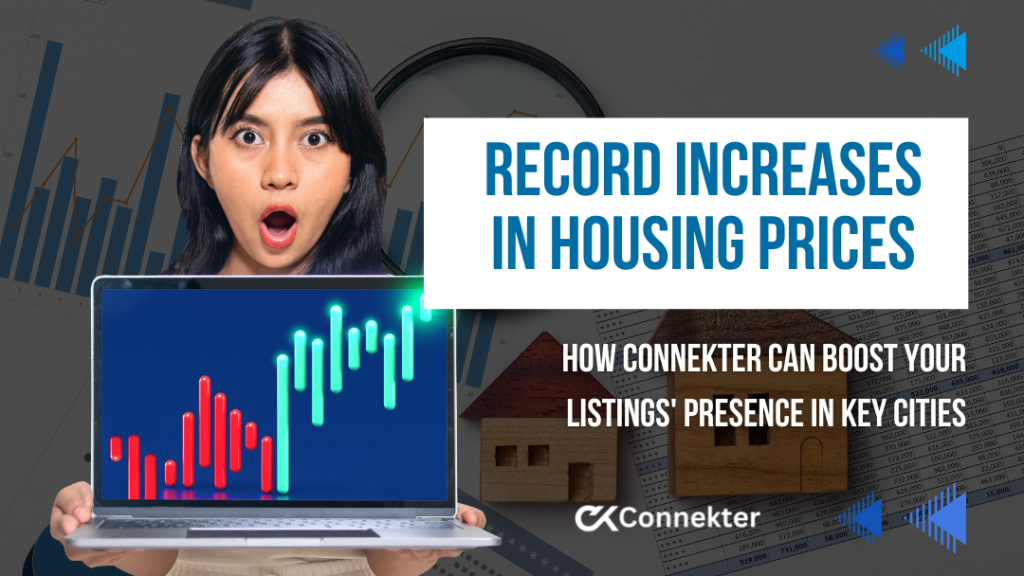
Price increases in real estate markets and their advantages
Did you know that in real estate markets, knowing the trends can take you to the top?
New York City boasts one of the most iconic housing markets in the world. Fueled by a vibrant economy and iconic status, it consistently attracts a wave of residents seeking a piece of the Big Apple dream.
However, before diving into this dynamic market, understanding current trends and pricing is essential.
This year is shaping up to be a pivotal moment in real estate, marked by evolving demand, shifting supply dynamics, and changing pricing patterns.
With the impending impact of fluctuating mortgage rates, the NYC housing market is poised for what could be a transformative year.
New York City Housing Market Report – 2024
Home Sales in real estate markets
The home sales data from StreetEasy reveals a notable uptick in home sales activity this year. In July alone, 1,984 homes entered contract, a significant 12.5% increase from the previous year.
As a resident of New York City, it has been fascinating to see the landscape shift, with more buyers showing intent to purchase despite historically high mortgage rates.
One key observation is the particularly vibrant activity in the middle-price segment of the market. Homes priced between $750,000 and $1.7 million spent an average of 61 days on the market, down from 71 days in July last year.
The rapid movement in the mid-priced homes category illustrates a resurgence of buyer confidence as more potential homeowners feel the pinch of rising rental costs and view purchasing as a favorable long-term investment.
Home Prices in Real Estate Markets
As of the latest data, the median asking price in New York City is $1.1 million, a figure that has remained consistent this year. While prices have stabilized at elevated levels, it’s worth considering whether the peak is near.
It is crucial to look at these figures in the context of the broader economic environment.
With the Federal Reserve expected to cut interest rates in September 2024, mortgage rates are gradually decreasing, slightly improving affordability for buyers.
However, the typical home sales are still pushing against an average median price point, which can feel daunting.
Interestingly, Brooklyn condo prices are on the rise, averaging nearly $1.1 million—a 9.7% increase from last year.
This continues to reinforce the notion that as neighborhoods develop and offerings diversify, some areas are becoming prime targets for higher returns.
Moreover shifting buyer preferences are evident. More purchasers are leaning towards condos over co-ops, primarily due to the greater flexibility in financing options that condos provide.
Housing Supply
New condos are emerging at a robust rate, signaling an important shift in inventory. For the first time since 2019, new condo listings have overtaken new co-op listings, with a remarkable increase of 5.5% year-over-year.
With 3,694 condos listed between May and July, it’s clear that sellers are responding to market demands—particularly in Manhattan and Brooklyn.
From my perspective, this change is not just about numbers; it’s reflects a broader attitude towards ownership in NYC.
Many buyers are now opting for condos over co-ops, largely due to more lenient financing arrangements and the absence of rigid application processes. This trend is particularly relevant for first-time buyers, who often face hurdles in traditional co-op applications.
However, inventory is not uniform across the city. The overall housing stock remains tight despite a surge in new listings.
As of July, 17,618 homes were on the market, a slight decline from last year. This indicates that while sellers are more willing to list their homes, inventory levels still create a competitive environment.
NYC Housing Market Trends
Analyzing market trends provides valuable insight into what to expect as we move deeper into the year.
The rise in new listings, combined with a decline in total inventory, paints a picture of a market in transition. Homes in the lower third price range (under $750,000) are seeing increased interest, with new contracts rising 13.5% year-over-year. This indicates a growing pool of buyers eager to enter the market.
One of the more compelling aspects of the current market dynamics is the increasing prevalence of price cuts.
Data indicates that 10.4% of homes on the market reduced their asking prices in July, compared to 10.1% the previous year.
This suggests that while demand remains strong, sellers may be reassessing their expectations, paving the way for more balanced negotiations as inventory increases.
Particular neighborhoods are driving the competitive nature of the market. For example, Queens has become increasingly competitive for starter homes, with 402 new contracts signed despite a decrease in new listings.
As an observer of local trends, I find it noteworthy how neighborhoods like Jackson Heights and Astoria are emerging as hotpots due to their desirable features and more affordable pricing.
Real Estate: How Does Connekter Fit Into My Business?
In addition to providing professional support for acquiring new clients, Connekter offers a reliable way to save time and resources. Many of its advantages stem from this premise.
Connekter works with pre-qualified clients, individuals who are already familiar with our services. As a result, they provide a higher likelihood of sales and greater security. The platform also integrates seamlessly with CRMs and other systems.
Connekter centralizes information, ensuring everything is in one place. Leads are sent directly to the client, who can then manage them through a user-friendly control panel. This provides easy access and streamlined management.
The time you would spend managing leads can now be redirected to other tasks, such as exploring new trends or focusing on daily activities. Additionally, you can visit our partner blog, where we share up-to-date information.
Another key feature of Connekter is its robust data segmentation. The platform collects and organizes information based on various criteria, such as the client’s budget, level of interest, and location.
Real Estate: Top Housing Markets for 2025
While nationwide home sales are expected to see only slight growth amid moderating home prices, some markets across the country are projected to experience significantly stronger increases in both sales and prices in 2025. Across these markets, we find a number of unifying themes:
- Regional concentration in the South and West;
- Significant recent sales growth and likelihood of maintaining that momentum;
- Abundant inventory; often driven by new construction.
- Younger populations, many with military connections or international ties;
- Factors that mitigate the impact of high mortgage rates. Such as higher shares of outright homeownership (no mortgage debt) and eligibility for government-backed loans like Veterans Affairs (VA) and Federal Housing Administration (FHA) loans; and
- Relatively lower-cost markets that continue to benefit from flexible work arrangements.

The Sun Belt Remains on Top
The top 10 markets for 2025 are concentrated in the South and West, with multiple markets from three states—Texas, Florida, and Virginia —rising to the top of the list. Other states represented include Colorado (Colorado Springs), Arizona (Phoenix), Georgia (Atlanta), and North Carolina (Greensboro).
Why are these markets in the top 10? From a technical standpoint, they rank highly because they are projected to lead in home sales and prices growth among the 100 largest markets kn 2025.
Beyond the technicalities, there is a clear correlation between the projected percentage increase in home sales for 2025 and the forecasted recovery of these markets to their 2017–19 home sales averages.
In simpler terms, the markets we’re forecasting to lead the country in home sales in 2025 are those that have recovered more effectively to pre-COVID-19 levels. These markets are expected to sustain that momentum in the coming year.
We’ve analyzed what sets these top markets apart and uncovered several key findings. even deeper into what separates our top markets from the rest of the pack. And have surfaced several key findings. These markets not only demonstrate strong recovery but also show potential to build on that momentum.
These markets also stand out for their housing inventory, which creates opportunities for buyers. However, affordability remains a challenge for many households, as it does in most areas.
Aspiring homeowners can take advantage of government-backed loan programs that facilitate lower down payments. These programs are especially beneficial for younger families with military or international connections, who often reside in these top market.
Real Estate: Buyers Have Options–Both New and Existing Homes for Sale
Nationwide, the recovery of housing inventory is well underway. With the number of homes for sale in November notching the highest mark since December 2019. However, this remains a glass half-empty or half-full story, as the housing market still lags 20% behind the 2017-2019 November average, despite significant gains.
Further, as we’ve pointed out in our monthly Housing Trends report. There is notable regional variation in the inventory recovery, with the South and West generally far closer to pre-pandemic inventory levels than the Midwest and Northeast.
This is undoubtedly a factor propelling home sales growth in the top markets. Half of which have active listing counts above 2019 levels in the most recent data.
New construction is an important part of the story. Eight of the top 10 metros have seen year-over-year growth in terms of single-family home permits issued year to date. While many of these same areas have seen declines in total permits issued as multifamily building lags.
Single-family permits are particularly relevant for the owner-occupied housing market, as most multifamily units are designed as rentals, while single-family homes are typically sold to owner-occupants.
Nationally, new-construction listings make up 17.3% of the listings on Realtor.com®. All but two of the top 10 markets (Miami and Phoenix) are near this mark or better.
Affordability in the Real Estate Markets
Responding to the lack of affordability in the housing market, homebuilders have recently focused on smaller homes to meet demand. In half of the 2025 Top Housing Markets, new-construction prices have decreased over the past year. However, in key markets such as Florida, Virginia, and North Carolina, new-construction prices continue to rise.
But new-home construction is not the only part of the story. A recovery of existing-home sellers in these markets seems to be giving home shoppers a variety of choices that is helping to propel sales.
In fact, despite the uptick in single-family home construction in these top markets. The share of new-construction home listings in 8 of the top 10 markets has fallen as a recovery in existing-home sellers balances the uptick in new homes for sale.
Outright ownership insulates some markets from the drag of still-high mortgage rates
McAllen is one of just two of the 100 largest housing markets where a majority of homeowners (61.7%) own their home without a mortgage. Among the top 10 markets, El Paso (49%), Miami (43.8%), and Greensboro (38.2%) are also areas where an above-average share of households own their home outright, without a mortgage.
Lower shares of homeowners with mortgage debt means that the mortgage rate lock-in effect has less bearing on home buying and selling decisions in these areas in the aggregate. Nationwide, our 2025 Housing Forecast anticipates that the mortgage rate lock-in effect will ease in 2025. But still be a limiting constraint for many households.
Flexible Work Benefits Relatively Lower-Cost Markets
Flexible work arrangements, including hybrid and fully remote options, remain appealing to homebuyers, particularly as overall affordability is expected to improve only modestly in 2025. A previous study by Realtor.com revealed that many home shoppers leverage flexible work modes to overcome affordability challenges, a trend likely to persist.
According to WFH Data, half of the top markets, including Richmond (11.8%), Atlanta (10.8%), Phoenix (10.6%), Colorado Springs (8.9%), and Orlando (8.8%). Have a higher share of fully remote or hybrid online job postings in 2024 compared to the average across the top 100 metros (8.6%).
Although markets like Virginia Beach (7.8%) and Greensboro (6.1%) have a lower share of remote or hybrid job postings.
The combination of relative affordability and moderate commuting proximity is expected to benefit these top housing markets.
Although the top markets generally have lower price point than the top-100 market average or the U.S. median. They are located in areas with relatively lower incomes.
Top 100 market average
As a result, despite their lower costs. The typical share of income required to afford a home in the top markets is projected to be 31.1%. Slightly above the national average of 29.2%. Miami sits as the high end of the range, at 42.1%, while Greensboro is at the low end, at 25%.
While housing affordability is not significantly better than average. The top markets do offer a slightly lower cost of living than the national average. The most affordable market is McAllen. Where the typical cost of necessities is about 13% below the national average. This, according to a Realtor.com analysis of regional price parities (RPPs) data from the Bureau of Economic Analysis.
At the opposite end of the spectrum is Miami, where the cost of living is approximately 11.5% above the national average. Overall, 7 of the top 10 markets remain more affordable than the U.S. average in terms of cost of living.
This analysis provides insight into key variables, particularly those influencing price changes by 2025. Staying informed and consistently optimizing your business strategies remains essential. Implementing the tools discussed here can help you achieve meaningful improvements.
Let Connekter integrate into your routine. Guarantee time and security. At the same time, you improve your results on the road to success in the changing world of real estate. Write us today!
Extra resources:
- Real Estate Investing for Beginners: 12 Expert Tips for Buying Your First Investment Property. Read more…
- Turning Real Estate Goals into Achievements: A Step-by-Step Guide. Read more here…
- Meet the Mentor Who Changed My Entire Real Estate Journey. See more…
- California Real Estate Guide. Learn more…
- Real Estate Market Forecasts for the US and Canada. Learn more…
- Guide to Retiring in the USA and Canada: Top Real Estate Tips. Learn more…

